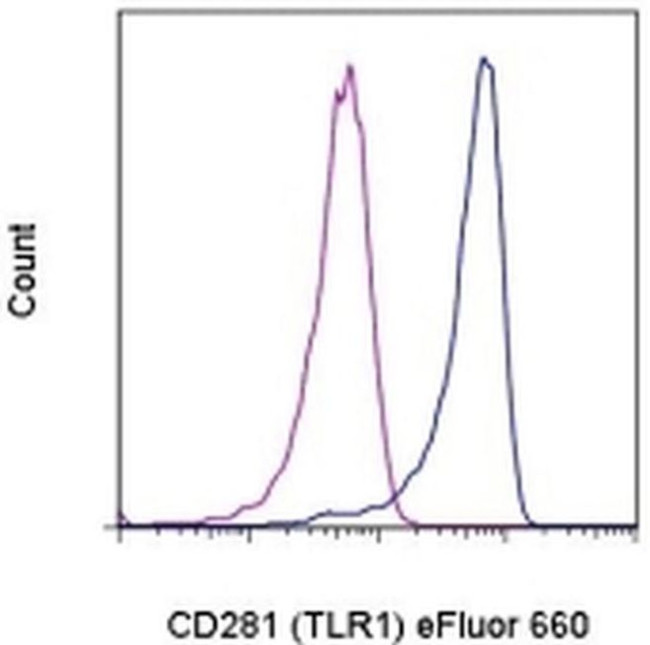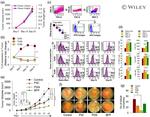Search Thermo Fisher Scientific
Invitrogen
CD281 (TLR1) Monoclonal Antibody (eBioTR23 (TR23)), eFluor™ 660, eBioscience™
Product Details
50-9011-82
Species Reactivity
Published species
Host/Isotype
Recommended Isotype Control
Class
Type
Clone
Conjugate
Excitation/Emission Max
Form
Concentration
Purification
Storage buffer
Contains
Storage conditions
Shipping conditions
RRID
Product Specific Information
Description: The eBioTR23 monoclonal antibody reacts with mouse Toll-like receptor 1 (TLR1, CD281). TLR1 is an approximately 98 kDa protein belonging to the Toll-like receptor family, and is closely-related to mouse TLR6 in both structure and function. Through the formation of a complex with TLR2, TLR1 is able to bind bacterially-derived triacyl lipopeptides, as well as soluble factors released from Neisseria meningitidis. TLR1 is expressed by macrophages and macrophages in TLR1-deficient mice display impaired production of inflammatory cytokines upon stimulation with triacyl lipopeptides and lipoproteins from mycobacteria.
Applications Reported: This eBioTR23 (TR23) antibody has been reported for use in flow cytometric analysis.
Applications Tested: This eBioTR23 (TR23) antibody has been tested by flow cytometric analysis of transfected cells. This can be used at less than or equal to 1 µg per test. A test is defined as the amount (µg) of antibody that will stain a cell sample in a final volume of 100 µL. Cell number should be determined empirically but can range from 10^5 to 10^8 cells/test. It is recommended that the antibody be carefully titrated for optimal performance in the assay of interest.
eFluor® 660 is a replacement for Alexa Fluor® 647. eFluor® 660 emits at 659 nm and is excited with the red laser (633 nm). Please make sure that your instrument is capable of detecting this fluorochome.
Excitation: 633-647 nm; Emission: 668 nm; Laser: Red Laser.
Filtration: 0.2 µm post-manufacturing filtered.
Target Information
TLR1 protein is a member of the Toll-like receptor (TLR) family which plays a fundamental role in pathogen recognition and activation of innate immunity. TLRs are highly conserved from Drosophila to humans and share structural and functional similarities. They recognize pathogen-associated molecular patterns (PAMPs) that are expressed on infectious agents, and mediate the production of cytokines necessary for the development of effective immunity. The various TLRs exhibit different patterns of expression. The Toll-like receptor (TLR) family in mammals are comprised of a family of transmembrane proteins characterized by multiple copies of leucine rich repeats in the extracellular domain and an IL-1 receptor motif in the cytoplasmic domain. The TLRs could constitute an important and unrecognized component of innate immunity in humans. In mice, TLR1 interacts with TLR2 and co-expression of TLR1 and TLR2 enhance the NF-kappaB activation in response to a synthetic lipopeptide. They recognize the lipid configuration of the native mycobacterial lipoprotein as well as several tri-acylated lipopeptides. Different length transcripts presumably resulting from use of alternative polyadenylation site, and/or from alternative splicing, have been noted for the TLR1 gene.
For Research Use Only. Not for use in diagnostic procedures. Not for resale without express authorization.
How to use the Panel Builder
Watch the video to learn how to use the Invitrogen Flow Cytometry Panel Builder to build your next flow cytometry panel in 5 easy steps.
Bioinformatics
Protein Aliases: CD281; TIL; Toll-like receptor 1; Toll/interleukin-1 receptor-like protein
Gene Aliases: Tlr1
UniProt ID: (Mouse) Q9EPQ1
Entrez Gene ID: (Mouse) 21897

Performance Guarantee
If an Invitrogen™ antibody doesn't perform as described on our website or datasheet,we'll replace the product at no cost to you, or provide you with a credit for a future purchase.*
Learn more
We're here to help
Get expert recommendations for common problems or connect directly with an on staff expert for technical assistance related to applications, equipment and general product use.
Contact tech support



